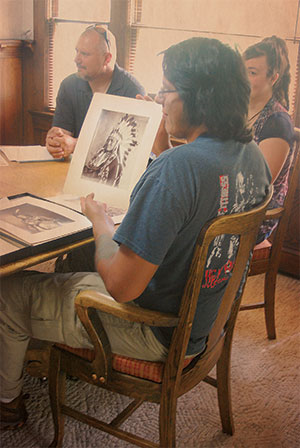RIVERTON COUPLE DONATE VALUABLE PHOTO COLLECTION, SCULPTURE
RIVERTON COUPLE DONATE VALUABLE PHOTO COLLECTION, SCULPTURE

A “significant” collection of antique photographs of Arapaho and Shoshone Indians has been donated to Central Wyoming College by Mary and Harmon Watt.
The Riverton couple also gave the college a working model of the Harry Jackson sculpture of Sacagawea.
“We didn’t have any photos of some of the people in these images,” said an elated Todd Guenther, who teaches history, anthropology and archaeology for CWC’s Western American Studies program.
The 26 photos and the sculpture will be housed in the CWC Intertribal Education and Community Center, which Harmon Watt said is a “logical place” for the collection. Harmon, a founding member and longtime leader of the CWC Foundation, and a group of investors were responsible for the purchase of the bronze life-sized statue of Sacagawea that was donated to the college and later moved to a site near the Intertribal Center.
The Watts immediately recognized the impact of their donation. Nico Holt, one of Guenther’s students, was present on the day the photos were presented by the Watt family. As Holt carefully perused through the collection he came upon the image of Dick Washakie, his great-great grandfather.
“Nico got really excited because he recognized him right off the bat,” Guenther said of Holt’s visible emotion when he spotted the Washakie photo. “The people he’s descended from are in those images.”
Several of the subjects were apparently photographed in a Denver studio and Guenther believes the photographer took his subjects “very seriously.” “This is a significant photo collection,” he said. “The quality of the photos is amazing.”
Guenther’s students have been collecting and displaying photographs of early Wind River Reservation inhabitants for years. They are also working with Riverton and Lander museums and both tribes to acquire and copy other original photos for use in exhibits and for classes and research.
Photos in the Watt Collection have not been seen since they were last exhibited in South Pass in the 1940s. The Watts admit the photographs had been kept in a drawer for decades in their Riverton home, which was built by E.T. Glenn, Harmon’s grandfather who is credited with opening the first store in Riverton.
The photographs were given to Harmon’s mother, Daisy, who came to Riverton when Riverton was first incorporated in 1906 on land ceded from the reservation. Daisy, who was just nine when she traveled to her new home on a stage coach from Montana, later befriended Nell Nickerson, the daughter of Captain Herman G. Nickerson.
The collection includes images of “Cap” Nickerson (1841-1927), an early business leader and politician in South Pass City. Nickerson ran a hotel in Lander where the movie theater is located today, and was an agent on the reservation at the turn of the century. Nickerson also held several political positions and is said to have written one of the earliest histories of central Wyoming and the South Pass area.
Guenther said Nickerson owed his appointment as agent on the reservation from 1897 to 1903 to President William McKinley with whom he served in the Civil War. Nickerson led a misguided attempt to anglicize Native American people by assigning them English names. And for that reason, Guenther was very surprised to find a photo in the collected works of Nickerson with Shoshone and Arapaho people dressed in traditional clothing at the second Cheyenne Frontier Days.
“This was a big deal,” said Guenther of the agent appearing with tribal members in native costume. “Nickerson and the government were trying to educate Indians and turn them into white people. It must have been a hot topic.”
While an agent for the reservation, Nickerson apparently took many trips with tribal leaders to Cheyenne, Denver and Washington, D.C., Guenther said. Most of the photos in the Watt Collection were taken in Denver around 1898-99. Two of the pictures were at the second Cheyenne Frontier Days where the tribal members performed with the Buffalo Bill Wild West Show.
It also came as a surprise to Guenther that Nickerson was involved with getting tribal members in the “entertainment” business as it went against his plan to take the Indians out of their traditional cultures.
“I wish I had this stuff last spring,” Guenther said of a class he taught on the early Tim McCoy westerns where hundreds of Wind River Reservation residents were hired. By the time the local Indians acted in McCoy’s movies, they had significant show business experience from the traveling shows. “They were both authentic and experienced actors and Hollywood ate it up,” he said.
He assumes Nickerson had some of the photos from the collection at his Lander home. His daughter married Fred Stratton Sr., and she apparently inherited the images. Fred Stratton Jr., exhibited the pictures at South Pass City, which he had purchased from the Sherlock family to run it as a tourist stop.
Stratton sold South Pass City in 1955 and moved back to Riverton and it is assumed Daisy acquired the photos from him around that time.
Mary Watt believes her mother-in-law ended up the with collection because of her long association with Indian people. She had run an antique store in Riverton and often sold the beadwork of local tribal people.
To protect the images, the college will never exhibit the original photos from the collected works as exposure to sunlight will cause them to fade. The students have already made high resolution scans and prints will be made for a display.
2660 Peck Avenue
Riverton, WY 82501
(307) 855 – 2000
Campus Map
120 Enterprise Blvd.
Lander, WY 82520
(307) 332 – 3394
Campus Map
240 S. Glenwood St #124
P.O. Box 4795
Jackson, WY 83001
(307) 733 – 7425
Campus Map
302 W. Ramshorn
P.O. Box 175
Dubois, WY 82513
(307) 455 – 2625
Campus Map
© 2024 Central Wyoming College – All Rights Reserved